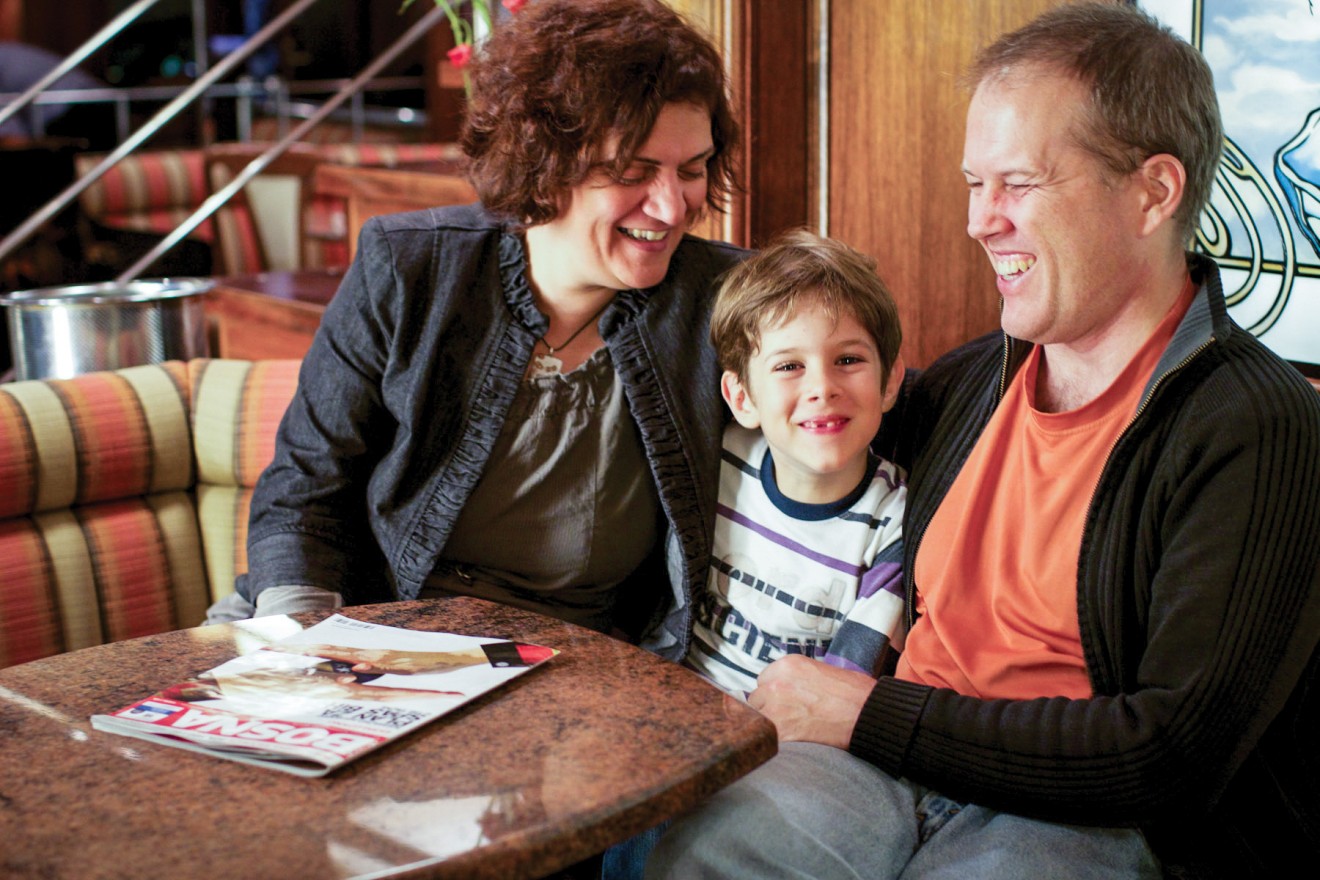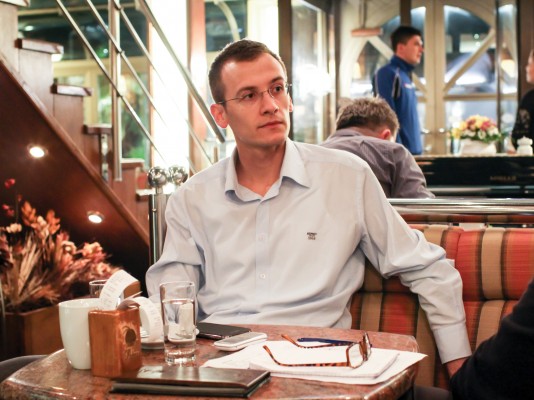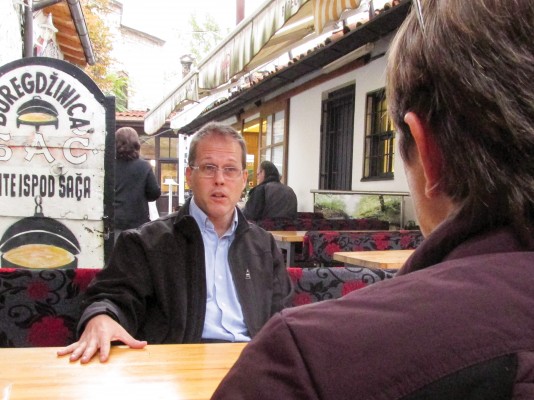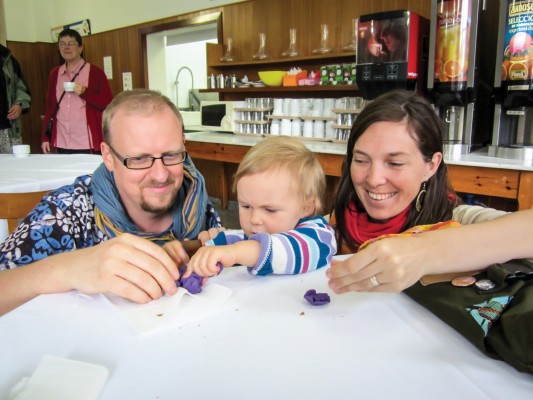
Much of Sarajevo still looks battered by the sniper fire and artillery shelling of a quarter century ago, with gashes in the gray concrete of the multi-story apartment buildings and half-demolished homes behind some garden fences.
Yet the setting is stunning. Heavily forested hills, with five big mountaintops, hug the valley where Sarajevo nestles along the placid Miljacka River. This 600-year-old city, now the capital of Bosnia and Herzegovina (BiH), must have been a breathtaking location for the 1984 Winter Olympics.
For a first-time visitor from EMU, it’s startling to realize that the hills lining Sarajevo – from which Bosnian-Serbian snipers and artillery terrorized Sarajevo for nearly four years in the early 1990s – are about as close to Sarajevo’s main street as EMU’s hill is to Harrisonburg’s Main Street. The constant barrage from the nearby hills killed 11,500 and wounded 50,000, almost all trapped civilians, many of them children.
In less than four years, Sarajevo was pummeled from being a multi-ethnic European city – with a mosque, Catholic church, Orthodox church and synagogue sometimes within blocks of each other – to being a rubble-strewn place where much of the population had lost their homes.
Today, 20 years after the U.S-brokered Dayton Peace Agreement ended open warfare, Saravejo is again a gracious-feeling city where Bosnians emerge in the evenings and on weekends for korzo – taking a walk, stopping to chat with friends, lingering in a kafana, or coffeehouse. In the oldest part of the city – where most Ottoman-era homes and buildings have been restored – restaurants and bars are full. New hotels have opened.
In the words of the Lonely Planet, “In the 1990s Sarajevo was on the edge of annihilation. Today it’s a vibrant yet very human city, notable for its attractive contours and East-meets-West ambience.” Yet underneath the loveliness savored by a growing trickle of tourists is this reality:
“The trauma of survival [has] shifted from running away from guns during the war to the present situation of not having enough money to feed the family and send children to school,” wrote Amela Puljek-Shank, MA ’04, in a Peacebuilder Online article posted May 20, 2012.
Amela said that the underlying tensions in the region were not being addressed. They were smoldering. In her 2012 article, Amela added:
In the former Yugoslavia, with the exception of Slovenia, we live under the constant threat of potential armed conflict.[1] This or that group wants to separate from this or that country. We justify the crimes committed in the region in the name of defense and out of fear. The politicians use this reality to get elected, stay in power and keep fear present, which increases mistrust and the inability to live together.
Through it all, I see the trans-generational transfer of trauma. My generation grew up hearing the stories of World War II’s horrors, and elements of these stories have been played in front of our eyes in these last wars in former Yugoslavia. As a society, we have successfully given a new generation our reservoirs of trauma and told them to carry it.

Little has changed in the years since Amela wrote this article, based on Peacebuilder interviews with a half-dozen people in Sarajevo in November 2014 including: Amela and her husband, Randy Puljek-Shank, MA ’99; a colleague of Amela’s, Tamara Šmidling; and human rights lawyer Nedim Kulenović. The four shared links with the Post-Yugoslav Peace Academy, which offered an annual 10-day training program modeled after EMU’s Summer Peacebuilding Institute, from 2007 through the summer of 2012.
“We are still a deeply divided society,” said Kulenović, who was one of 60 participants in the 2012 Peace Academy, the most recent one held. The mix of ethnicities in the classroom – Bošniaks with Muslim roots, Croats with Roman Catholic roots, and Serbs with Orthodox Christian roots – surfaced tensions, but the Peace Academy provided safe space to wrestle healthily with the tensions, he said.
Too many schools in BiH are sharply separated along ethnic lines, Kulenović explained. Children from the same neighborhood may walk to different schools, or even different ends of the same divided building. They’ll study different historical narratives, which extoll their own ethnicity and degrade others. The same neighborhood may have multiple fire brigades, one for each ethnicity.
Discrimination of one group against another (the group in the majority shifts from district to district, or even town to town) is rampant, says Kulenović, who works for Vaša Prava BiH, a network of 30 human rights lawyers in nine offices, supported heavily by grants from funders outside of BiH, including the Canada Fund for Local Initiatives, the UN High Commissioner for Refugees, the European Commission, and Open Society.[2]
Kulenović and his fellow lawyers can and do file suits to address injustices. But he would like to see more being done to shift the underlying culture, the prevailing social attitudes, that give rise to injustices. And this is where the Peace Academy was positioned when it operated for those five years – preparing people to return to their home settings to do a conflict analysis and determine partnerships and pathways for detoxifying their society.
Donor issues
“Donor policies, I don’t understand them” – Tamara Šmidling was expressing her frustration at the end of a long Thursday on the heels of an exhausting trip to assess the needs of refugees in camps in the Middle East.[3]
But Šmidling’s six words were ones her listener, a reporter with Peacebuilder magazine, had heard (and would hear) in many forms, many times, during six weeks at the close of 2014 while interviewing peace-committed people in nine countries, including Bosnia and Herzogovina.
These people were all intent on sweeping up the embers of violence in their societies and replacing these red-hot embers with skills and materials for building peace. Yet almost all the interviewees felt frustrated that they were more likely to see an infusion of donor dollars if their regions were hit suddenly with flooding and mudslides than if peacebuilders were making slow but steady progress toward enabling people to live cooperatively.

And that is what Šmidling was wearily referring to.
In mid-May 2014, for example, her country had declared a state of emergency when rain poured down so heavily in three days, it exceeded what would normally fall in three months. Dozens died, hundreds were injured, and hundreds of thousands had to evacuate their homes. Potable water ran short, electricity failed. Landslides exposed live landmines from the 1990s war.
Bosnian governmental systems were (and remain) largely non-functional, so families, neighbors and citizens helped each other to the best of their ability. But with half of the country unemployed, local resources were limited. Some disaster relief came from outside the country, including some provided by Mennonite Central Committee (MCC) in North America.
Being an MCC staffer, Šmidling obviously is not opposed to disaster relief. Šmidling just wishes donor dollars flowed as readily and more steadily toward long-term projects, like the Peace Academy in Sarajevo that she helped launch in 2007.
The Peace Academy
MCC provided the seed money for this Peace Academy, which enabled it to run for 10 days, two summers in a row. Then the Balkan Trust for Democracy added some funding to MCC’s, and the Peace Academy functioned for another three summers (current CJP academic dean Jayne Docherty taught there in 2012). The Peace Academy averaged more than 150 applicants for the 60 seats available each session.
Participants contributed toward the cost of their classes, each running five full days at a time, based on their ability to pay, from 50 to 350 Euros per class, including room and board. In a region where unemployment runs at about 50% – and those lucky enough to have jobs earn low wages – some participants struggled to pay the minimum 50 Euros. The actual cost was 600 to 700 Euros per participant, so heavy subsidies were needed for each.
“We explored nationalism, mass violence, crimes, collective identities and their connection with past war crimes, nonviolent movements and gender issues,” said Šmidling, who previously was a trainer for the nonprofit Center for Nonviolent Action in BiH. “We were the one place in the region where scholars and activists could meet and find common ground.”
These topics drew heavily on the coursework that Šmidling did at EMU’s 2005 Summer Peacebuilding Institute, where she studied the legacy of violence and addressing this legacy through transitional restorative justice; navigating cross-cultural differences; and the roles of ritual and the arts in peacebuilding.
In addition to Šmidling, two of the other six organizers of the Peace Academy were alumni of CJP – Amela and Randy Puljek-Shank both had master’s degrees in conflict transformation from CJP and were serving as co-representatives for Southeast Europe with Mennonite Central Committee from 2002 to 2011. (Amela’s home city is Jajce in western BiH, from which she fled when it came under siege in the early 1990s. See the following article titled “From war survivor to MCC administrator.”)

Online surveys of former participants found that the Peace Academy approach worked well. They ranked all of the classes highly. They appreciated coming to one place where people of all types – all ethnicities, both genders, a range of ages, urban and rural, scholars and laborers – could learn together and from each other, sharing meals and socializing outside of classes.
Learning occurred interactively, using the “elicitive” approach popularized by CJP’s founding director John Paul Lederach, said Amela. It was peace education with a clear purpose – to prepare people from all walks of life to work for lasting change. “Bringing practitioners from across the Balkans to learn theories of peacebuilding, alongside academics learning about practice – this brought fresh air to both groups,” she said.
By Year 3 of the Peace Academy, however, MCC was realizing it did not have the resources to indefinitely support the academy without other donor partners. And the Balkan Trust also said its support was short-term.
“For a year and a half, we sent out proposals – I don’t know how many – to dozens of addresses worldwide,” said Šmidling. But no foundation or international agency seemed interested in investing in long-term, grassroots peace trainings in the Balkans. The area was no longer making news with a civil war, as it was in the early 1990s. It was out of view in the global media, end of concern.
Then, in February 2014, thousands went into the streets of Bosnia-Herzogovina to protest the rocket-high unemployment rate, unpaid wages (from bankrupt factories), and grinding poverty. They burned dozens of government buildings, expressing fury at the political inertia in the country following the Dayton Peace Agreement in 1995. The riots left about 300 injured.
Soon thereafter Šmidling heard donor agencies talk about the need to focus on social justice issues in her country. A few months later came the torrential rains and flooding, and donors helped with that crisis.
“Crises are what keeps them [foreign funders] alive and brings in their money,” Šmidling noted. “Instead of preventing crises– or equipping ourselves to better handle them peaceably – we have to wait for them to happen to get the world’s attention. It’s a vicious circle.”
Bottom up peacebuilding
The toxicity in the Balkans is understandable, given the recentness of brutal warfare affecting almost everyone in horrible ways.
The world is familiar with the Nazis’ genocidal acts in World War II, including in BiH (then part of the Kingdom of Yugoslavia). But many may not realize that such acts occurred again when Serbs led by Slobodan Milošević began to systematically eliminate Bosnian Muslims.
Milošević’s militias forced repopulation of entire towns, putting men and boys in make-shift concentration camps. In some locations, Muslim males were killed en masse, with hundreds at a time buried in unmarked trenches. Between 20,000 and 50,000 women, mainly Muslim, were raped, according to some estimates.
The United States was roused to initiate military intervention when a Serb-launched mortar shell hit the Sarajevo marketplace, killing 68 and wounding nearly 200 on February 6, 1994.
By the time a U.S.-brokered peace accord was signed on December 14, 1995, over 104,000 people had been killed, according to the International Criminal Tribunal for the former Yugoslavia. More than 20,000 were missing and feared dead, while 2 million had become refugees and displaced.
The Dayton Agreement set up a multi-layered, confusingly diffuse array of governmental jurisdictions across the country, based on ethnicity. The result, by all accounts, is permanent paralysis. No government agency, for example, can organize a conference to develop a school curriculum that would cease the vilification of different ethnicities. No such country-wide agency exists.
To change the functioning of the various governmental bodies would require changing the constitution emerging from the Dayton Agreement, and the Parliament of the Federation Bosnia-Herzogovina is far too divided for such a task. So the country is frozen from the top down.
The Peace Academy was trying to work the other way – from the bottom up in building a viable, truly democratic state. Nedim Kulenović, the human rights lawyer, notes that a federal system can work in a multi-ethnic society (pointing to Switzerland’s multi-lingual nationhood), but it has to rest on a foundation of fiscal equalization and social harmony.
“We prefer to view religion as a resource for peace, not just a dividing factor,” says Randy Puljek-Shank, who is a PhD candidate at Radboud University in the Netherlands, researching “legitimacy and civic agency of civil society actors in Bosnia-Herzegovina.”
Living in the region since the 1990s war (Randy was a Mennonite relief worker when he met Amela), Randy notes that peacebuilding needs to begin with where people are currently clustered, which is largely not in secular, multi-ethnic organizations. “Unfortunately, many international donors come with a strong bias – they are anti-religious and anti-ethnic, which is a problem getting funding for working here,” he says. “The organizations with the most local legitimacy are not organized along the lines that the donors would like to see.”
Randy also bemoans the short timeline of most big-time donors. “International donors tend to operate on a two-year time frame. This leads to formalism – to the appearance of doing something significant, such as holding a big conference. But if the conference makes no difference – maybe even occurs in a time frame when everything gets worse – the donors just shrug and say, ‘That’s not my problem.’”
Randy is of two minds. On one hand, he would love for some major donations, committed for at least five years, to ensure that the Peace Academy is on solid footing with a professional staff. On the other hand, he wonders if it would be better to forget about putting the Peace Academy on a professional basis and to “go back to our roots” and run it informally as activists, making it into a movement that strengthens ties among networked activists.
Amela didn’t agree that this second approach was doable. Interviewed on the heels of a draining 14-day trip to MCC programs in Lebanon, Iraq and Jordan with Šmidling, Amela reminded Randy that the two of them and Šmidling had exhausted themselves for more than five years, often working 14-hour days, trying to do their regular work, while trying to get the Peace Academy up and keep it running.
When the academy stopped functioning after the summer of 2012, “we lost continuity, we lost rapport with previous participants,” said Amela. “It is difficult to build a good reputation in peacebuilding – people [in the Balkans] are feeling disillusioned with the whole concept. We needed to keep it running for at least a decade – you just cannot stop.”
But how do you run something for a decade on volunteer labor in a country where everyone is scrambling to survive financially, where nobody has the time to step up and be the one in charge?
Randy conceded, “It’s hard to direct things collaboratively – ownership of the project becomes diffused. We [the six volunteer organizers, representing four organizations] divided up tasks among ourselves, and things weren’t getting done. We needed to step back and be a board and hire a director and a staff.”
But even doing that requires a major investment at the front end – as other peacebuilding institutes covered in this issue of Peacebuilder demonstrate – before an organization can find a way to be self-supporting.
Ongoing trauma

Everyone interviewed by Peacebuilder in BiH saw the need for widespread trauma healing of the type provided by CJP’s Strategies for Trauma Awareness and Resilience (STAR), plus an understanding of identity issues. Amela summed up the situation in her 2012 article thus:
The longer we are here, the more we understand the significance of trauma education in the Balkans. We continue to take parts of STAR and adjust and adapt it for different aspects of our work. STAR is a cutting-edge approach to trauma across the world. It covers not only how you deal with it on a psychological level, but how it affects your entire being, including physical, mental, emotional and spiritual.
Seeking better grounding in addressing the aftermath of war, the successors of Amela and Randy as MCC representatives for East Europe, Ruth Plett and Krystan Pawlikowski,[4] did coursework at the 2014 Canadian School of Peacebuilding.[5] Plett took STAR, instructed by CJP staffers Elaine Zook Barge and Vernon Janzti, while Pawlikowski took “Arts-Based Approaches to Community Peacebuilding.”
Interviewed in their MCC office in Sarajevo, Plett and Pawlikowski were backed by wall-mounted photos of about 20 projects and organizations that MCC has long supported in BiH, Croatia, Serbia, Kosova/o, Ukraine and Russia – ranging from a Muslim organization that runs soup kitchens, to a number of orphanages, to an interfaith choir that sings music from all of the singers’ religions.[6]
Amela and Randy translated STAR materials from English and used them for trauma trainings in 2005 and 2006. They were partly motivated by “Franciscans [who] came to us and said that people were coming to their priests, feeling suicidal,” said Randy.
Today there is a trauma center that evolved from those trainings, located at the Bread of Saint Anthony, a Franciscan charity. These trauma materials and approaches also radiated out to MCC-supported partners, like a center that works with veterans from Bosnia, Serbia and Croatia.
“They offer a basic training where the veterans come from different sides of the conflict,” explained Amela in her 2012 article. “During these week-long trainings, they share about their experiences with war. It is very intense, but it offers a space to listen, empathize and break down prejudices.
“The organization stays in touch with these veterans and gives them the opportunity to be involved in peacebuilding activities, such as developing videos about the consequences of war, visiting each other’s front lines, and seeing each other’s memorials.”
Amela says she hopes the Peace Academy, which will reopen on a limited basis in 2015 and resume fully functioning in 2016 (if funding works out, as Šmidling fervently hopes), will focus on “developing resilience in our society” through understanding the multi-generational impact of trauma and how to break cycles of trauma. “Trauma can be not only a curse,” she says, “but a gift.”
Footnotes
- Wars raged in Slovenia in 1991, in Croatia 1991-95, in Bosnia-Herzegovina 1992-95, and in Kosova/o 1999-2000.
- According to its website (vasaprava.org), Vaša Prava BiH’s “core activities are directed to the removal of deep-seated barriers to equality of opportunity and outcome, such as discriminatory laws, customs, practices and institutional processes.” It also entails concern with the development of the freedoms of all individuals, irrespective of gender; to choose outcomes they have reason to value.
- Tamara Šmidling reports to the director of MCC’s Europe and Middle East office, Amela Puljek-Shank, MA ’04.
- Both families – that of the Puljek-Shanks and of Plett and Pawlikowski and their respective children – live in Sarajevo. At the beginning of 2013. Amela became the supervisor of the East Europe office staffed by Plett and Pawlikowski, in addition to overseeing MCC’s work throughout the rest of Europe and across the Middle East.
- This school was co-founded by CJP grad Jarem Sawatsky in 2009 and is covered at length in a separate Peacebuilder 2014-15 article.
- The funding from MCC that each project receives ranges from $5,000 to $20,000 (U.S.). MCC would have to bleed these other worthy projects to be the sole supporter of the Peace Academy, which Plett and Pawlikowski are understandably unwilling to recommend.